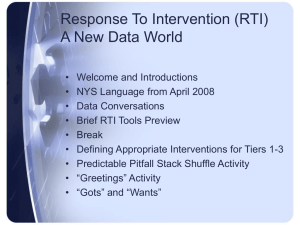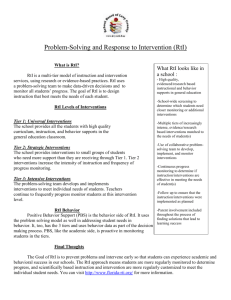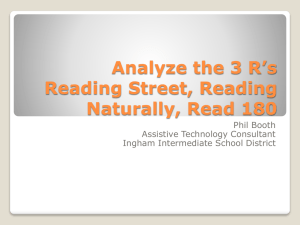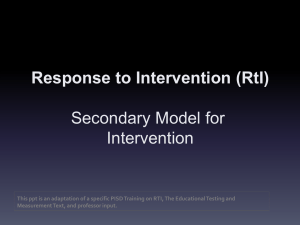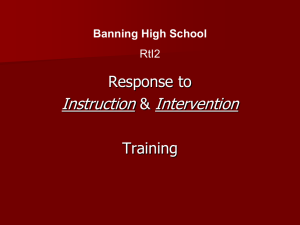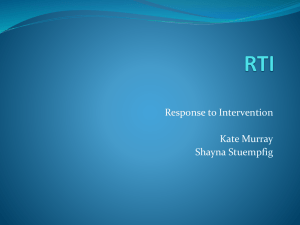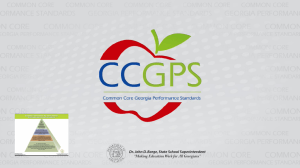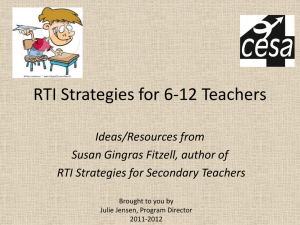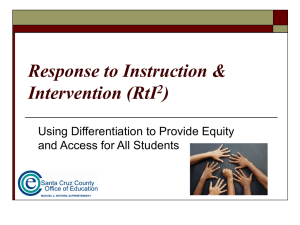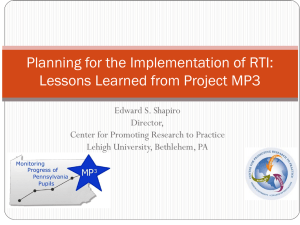RTI Response to Intervention - Student Support Services
advertisement
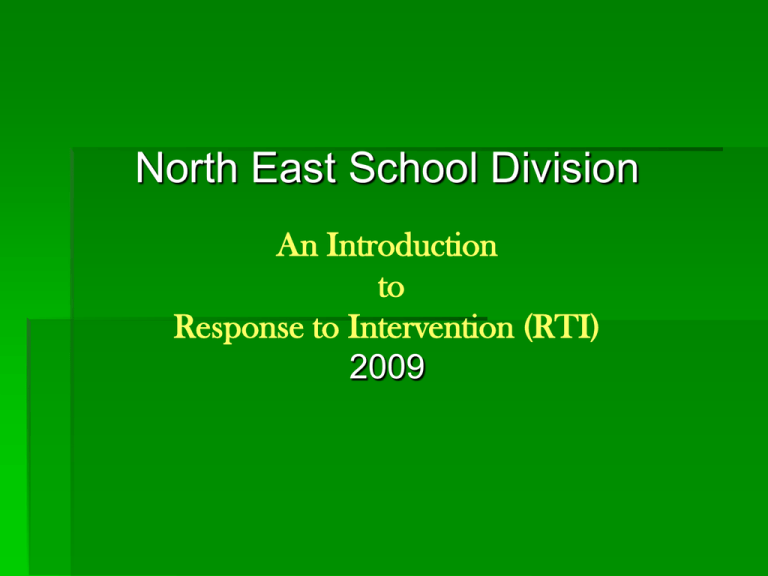
North East School Division An Introduction to Response to Intervention (RTI) 2009 KEY QUESTION What do we do when students don’t learn?? Utilization of the Pyramid Response to Intervention framework will create an effective process for all NESD teachers, administrators, support personnel and division staff to answer this question. What is Pyramid Response to Intervention? It is the practice of providing high-quality instruction and interventions that match student's needs and using students’ learning rate over time and level of performance to make important educational decisions. It is…… RTI or Response to Intervention is an approach that promotes a well integrated system connecting general, compensatory, gifted , and special education in providing high quality, standards-based instruction/intervention that is matched to student’s academic, social-emotional, and behavioral needs. It is….. A continuum of intervention tiers with increasing levels of intensity and duration is central to RTI. Collaborative educational decisions that are based on data derived from frequent monitoring of student performance and rate of learning. Timely, Directive, Systematic, Flexible Support Using this process allows students to receive timely interventions at the first indication that they need more time and support. This process should be directive rather than invitational, so that the students get the extra help they need, consistently and without interruption until they are successful. Interventions are sequences to build upon each other, from least to most restrictive, from least to most intensive, and from what happens in every classroom for all children to what happens for individual students who need highly focused, targeted help. It is not…. RTI is not a program but rather a process for ensuring that all students learn. RTI is not another add on. 3 Tiers Pyramid of RTI Support Intensive Interventions focused on closing the gap. TIER 3 Immediate and powerful targeted interventions systematically applied and monitored for any students not achieving. TIER 2 A coherent and viable core curriculum that embeds ongoing monitoring for all students. TIER 1 A Focus on Learning* A collaborative Culture* A Focus on Results Why use this model? When schools operate as professional learning communities, create a pyramid of intervention, they create the opportunity for powerful change. It is believed that these three ideas will unite the longseparated worlds of regular education and special education to create a unified system of schooling. With the demise of the “wait to fail” model, we can now move toward a systematic, directive, and timely response to all children when they don’t learn adequately regardless of labels or subgroups. A Three-Tier RTI Model While there is no single, thoroughly researched and widely practiced “model” of the RTI process, it is generally defined as a three-tier (or 3-step) model of school supports that uses research-based academic and/or behavior interventions. At all stages of the process, RTI should focus on discovering how to make the student more successful rather than focusing on the student’s lack of success. Tier 1 (A coherent and viable core curriculum that embeds ongoing monitoring for ALL students.) A Tier 1 curriculum must be prioritized so that the students have ample opportunity to master power standards. It must also include a component that specializes instruction and learning based on individuals’ and small groups’ disparate needs. The most important step a school can take to improve its core program is differentiating instruction. In Tier 1, educators meet individual student needs by differentiating the support and time they offer. If they need further support (tier 2 or 3), the process that has been established should be followed. Tier 1 Approximately 75-80% of the student population will have their educational needs met by Tier 1 interventions. Tier 2 (Immediate and powerful targeted interventions systematically applied and monitored for any student not achieving.) The level of the pyramid where supplemental interventions are implemented for students who’s educational needs have not been met by the core program. Small group interventions. An additional 10-15% of the student population will benefit from Tier 2 interventions. Tier 3 (Intensive Interventions focused on closing the gap.) The level of the pyramid where intensive individual interventions are implemented for student’s whose educational needs have not been met in Tier 1 or Tier 2. 5-10% of the student population will require these types of interventions. Others we work with are using this model. Various agencies and departments are utilizing similar procedures that are represented within this model. One example of this is the Ministry of Education and their RTI model that is used to identify Intense Level Students. Saskatchewan Ministry of Education *Promising approach *Sound instructional principles such as intervening early, using research based interventions, *Monitoring students’ progress; and using assessments to inform instructional decisions. An Effective Response to Intervention Pyramid … Will have academic as well as behavioral interventions in all 3 tiers. Will be built upon a strong core program. Will have established identification, placement and monitoring processes. Overview Successful implementation of the RTI process becomes the collective responsibility of the entire system – both at the school and division level. The RTI framework will be most effective if it is implemented using the PLC format. Division What does this RTI Pyramid look like within our division? Your administrator will hand out a copy of this Division Pyramid Your School What does this look like in your school now? What could it look like, now that you are more familiar with this pyramid? Activities Discussion

